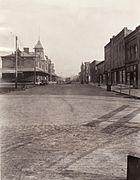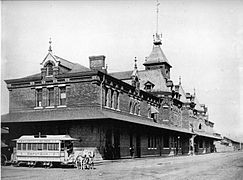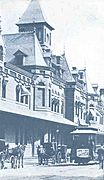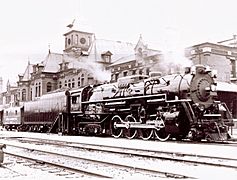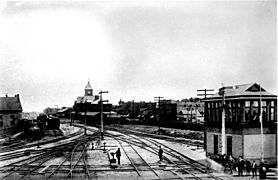East Saginaw station facts for kids
Quick facts for kids Flint and Pere Marquette Railroad East Saginaw Depot |
|
|---|---|
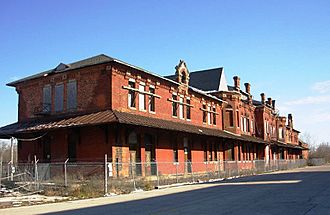 |
|
| Alternative names | Potter Street Station |
| General information | |
| Type | Railroad Station |
| Location | 501 Potter Street Saginaw, Michigan |
| Coordinates | 43°26′27″N 83°56′06″W / 43.44076°N 83.9351°W |
| Completed | 1881 |
| Technical details | |
| Floor count | 2 1/2 stories |
| Design and construction | |
| Architect | Bradford Lee Gilbert |
|
Flint and Pere Marquette Railroad East Saginaw Depot
|
|
| Architectural style | Late Victorian |
| MPS | Center Saginaw MRA |
| NRHP reference No. | 96001378 |
| Significant dates | |
| Designated | November 29, 1996 |
The Potter Street Station is a historic railroad station. It was built in 1881 in Saginaw, Michigan. This large building is located at 501 Potter Street.
A famous architect named Bradford Lee Gilbert from New York City designed it. The station is 285 feet long and 40 feet wide. It has two and a half stories. It was once the second largest train station in Michigan.
Contents
Building the Potter Street Station
Before the Flint and Pere Marquette Railroad came to Saginaw, the city was split. There was Saginaw City (the older west side) and East Saginaw (the newer east side). Sometimes, these two parts of the city would compete.
The railroad company, F&PM, wanted to build tracks through East Saginaw. They planned to cross the river and have stations on both sides. But officials from Saginaw City disagreed. They wanted the railroad to come through their older part of town.
Business owners in East Saginaw fought back. They encouraged the F&PM to avoid Saginaw City completely. They even bought a large piece of land for a station and train yards. This land was near Washington and Potter Streets.
The Saginaw Daily Courier newspaper wrote about the station in 1881. They said it was the biggest train station in Michigan. They also noted it was built to be useful and strong, not just fancy.
Over time, the F&PM railroad company changed. It became part of the Pere Marquette Railway in 1900. Later, in 1947, the Chesapeake and Ohio Railway bought it.
In 1950, train service for passengers stopped at the station. By 1955, the owners thought about tearing it down. They wanted to build new offices there. But this never happened. The station was used by train crews until 1986. Then, CSX Transportation, the new owner, closed it.
Today, the station is empty. A group called The Saginaw Depot Preservation Corporation (SDPC) owns it. This non-profit group works to save the station. In 1991, a fire badly damaged the building. The SDPC got money in 1993 to fix the roof. They are still trying to get funds to repair and protect the station.
The Potter Street Station is important for its history. It was added to the National Register of Historic Places in 1996. This means it is a special historic building.
Station History Timeline
- 1857: A railroad company was started in Saginaw. Its goal was to build a train line from Pere Marquette (now Ludington) to Flint.
- 1859: The first section of the Flint line was laid. It was near Washington and Potter Streets.
- 1862: The Flint & Pere Marquette Railroad opened its first track. It went from Saginaw to Mount Morris. The first trip was on January 20.
- 1881: The Potter Street Station was built. This was a busy time for train travel.
- 1950: Passenger train service stopped at the Potter Street Station. Cars and better roads became more popular.
- 1955: The Chesapeake & Ohio Railways, who owned the station, thought about tearing it down.
- 1964: The last passenger train left Saginaw. It was a New York Central Railroad coach called the Beeliner.
- 1986: The Potter Street Station was officially closed by CSX Transportation.
- 1988: CSX offered to sell the station to Saginaw City for just $1.00. The city said no because of the cost to maintain it.
- 1989: City officials ordered CSX to tear down the station. But people who loved railroads and history worked to save it.
- 1989: CSX sold the station to the Saginaw Depot Preservation Corporation for $10,000.
- 1990: In January, the Saginaw Depot Preservation Corporation officially took ownership.
- 1991: The Saginaw City Council again suggested tearing down the station.
- 1991, April 16–17: A fire caused serious damage to the Potter Street Station.
- 1993: In January, Michigan Governor John Engler gave a grant of $181,600. This money helped stabilize the damaged station.
- 1998: The station's roof was repaired.
- 2007: A grant of $1 million was offered by the United States Department of Housing and Urban Development. However, the group could not meet the rules in time, so they did not receive the money.
What the Station Looks Like
The East Saginaw Depot is a large building. It is made of red brick and has a hip roof. Stone trims decorate the building. The structure includes the main station and a smaller building next to it. This smaller building was likely for a boiler or power.
The station is long and narrow. It is about 285 feet long and 40 feet wide. Both sides of the building look very similar. There are three sections that stick out. The middle section is square, and the ones on the sides have slanted walls. These sections rise up to a roof that crosses the main building.
Large dormer windows with rounded arches are set into the roofs. A tall, square tower with a pyramid-shaped roof sits on top of the station. The outside has special details. These include darker brick lines around windows and doors. There are also brick designs and patterns.
A single-story roof, like a shed, goes around the building. It is held up by big iron brackets. The smaller boiler house building is square and has two stories with a hip roof.
The station and the nearby building are at one end of a large freight yard. This yard is used by the Lake State Railway. Train tracks cross Washington Street and then the Saginaw River. From there, trains can go to Flint or west towards Breckenridge.
Gallery


